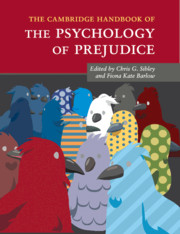Book contents
- Frontmatter
- Dedication
- Contents
- List of Figures
- List of Tables
- Notes on the Contributors
- Part I General Theoretical Perspectives
- Part II Prejudice in Specific Domains
- 11 Understanding the Nature, Measurement, and Utility of Implicit Intergroup Biases
- 12 Aversive Racism and Contemporary Bias
- 13 Ambivalent Sexism in the Twenty-First Century
- 14 Sexism in Intimate Contexts: How Romantic Relationships Help Explain the Origins, Functions, and Consequences of Sexist Attitudes
- 15 Religion and Prejudice
- 16 Sexual Prejudice: Advances in Conceptual and Empirical Models
- 17 Weight Bias: Prejudice and Discrimination toward Overweight and Obese People
- 18 Prejudice Against Immigrants in Multicultural Societies
- 19 Generalized Prejudice: Old Wisdom and New Perspectives
- Part III Prejudice Reduction and Analysis in Applied Contexts
- Index
- References
11 - Understanding the Nature, Measurement, and Utility of Implicit Intergroup Biases
from Part II - Prejudice in Specific Domains
Published online by Cambridge University Press: 17 November 2016
- Frontmatter
- Dedication
- Contents
- List of Figures
- List of Tables
- Notes on the Contributors
- Part I General Theoretical Perspectives
- Part II Prejudice in Specific Domains
- 11 Understanding the Nature, Measurement, and Utility of Implicit Intergroup Biases
- 12 Aversive Racism and Contemporary Bias
- 13 Ambivalent Sexism in the Twenty-First Century
- 14 Sexism in Intimate Contexts: How Romantic Relationships Help Explain the Origins, Functions, and Consequences of Sexist Attitudes
- 15 Religion and Prejudice
- 16 Sexual Prejudice: Advances in Conceptual and Empirical Models
- 17 Weight Bias: Prejudice and Discrimination toward Overweight and Obese People
- 18 Prejudice Against Immigrants in Multicultural Societies
- 19 Generalized Prejudice: Old Wisdom and New Perspectives
- Part III Prejudice Reduction and Analysis in Applied Contexts
- Index
- References
Summary
On July 17, 2014, plain-clothed officers from the New York Police Department (NYPD) approached Eric Garner, a 43-year-old African American man suspected of selling loose cigarettes. Garner argued he had not done anything wrong and wanted to be left alone. Officer Pantaleo attempted to handcuff Garner, who moved his arms asking not to be touched, after which Pantaleo put Garner in a chokehold from behind and pulled him to the ground. Other officers surrounded Garner, while Pantaleo pushed Garner's head down to the sidewalk. In a video of the incident, Garner is heard screaming, “I can't breathe” several times before losing consciousness. Seven minutes passed before an ambulance arrived, during which time, CPR was not performed. Garner was declared dead on arrival at the hospital.
Within a few months of this incident, other cases of police brutality toward young African American men came into the spotlight, including the fatal shootings of Michael Brown in Ferguson, Missouri; Tamir Rice in Cleveland, Ohio; Akai Gurley in Brooklyn, New York; and John Crawford near Dayton, Ohio. The common link between all these shootings was that they involved police officers and African American males between ages 12 and 43. Following the failure to indict officers involved in these cases, widespread demonstrations on the street called for justice (Gambino, Thrasher, & Epstein, 2014). Social movements including Twitter's “#BlackLivesMatter” and “#ICan'tBreathe” also called for action against police violence toward African Americans.
Despite public outcry over these cases, national surveys revealed a clear racial gap in perceptions of such incidents. Whereas 80% of African Americans believed that the shooting of Michael Brown raised racial issues that warranted discussion, only 37% of White Americans believed so. By contrast, 47% of White Americans believed race was getting more attention than it deserved (Anderson, 2014). To some individuals, race was irrelevant because there was no overt expression of racism. US Congressman Peter King, for example, argued that racial bias was irrelevant in Garner's death because racial epithets were not used by the police, and the officers would have treated Garner the same if he were a White male (Levine, 2014). Yet, federally collected data on police shootings reveal that young African American men are 21 times more likely to be shot dead by police than their White counterparts (Gabrielson, Jones, & Sagara, 2014).
- Type
- Chapter
- Information
- The Cambridge Handbook of the Psychology of Prejudice , pp. 241 - 266Publisher: Cambridge University PressPrint publication year: 2016
References
- 6
- Cited by



